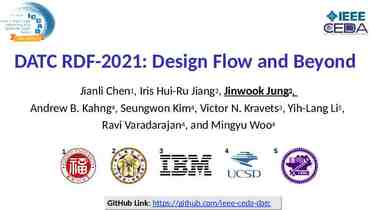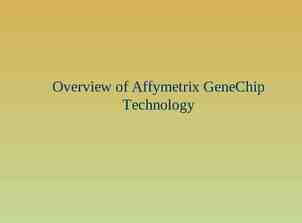I believe things like DNA computing will eventually lead the way to
20 Slides595.71 KB
I believe things like DNA computing will eventually lead the way to a “molecular revolution,” which ultimately will have a very dramatic effect on the world. L. Adleman DNA Computing COMP308
Presentation Outline Basic concepts of DNA Origin of DNA Computing Solution for NP-Complete Problems Advantages of DNA Computing Problems with Adleman’s Experiment DNA Computers
What is DNA? All organisms on this planet are made of the same type of genetic blueprint. Within the cells of any organism is a substance called DNA which is a double-stranded helix of nucleotides. DNA carries the genetic information of a cell. This information is the code used within cells to form proteins and is the building block upon which life is formed. Strands of DNA are long polymers of millions of linked nucleotides.
Graphical Representation of inherent bonding properties of DNA
Double Helix shape of DNA The two strands of a DNA molecule are anti parallel where each strand runs in an opposite direction. GC base pair and AT base pair
Basics And Origin of DNA Computing DNA computing is utilizing the property of DNA for massively parallel computation. With an appropriate setup and enough DNA, one can potentially solve huge problems by parallel search. Utilizing DNA for this type of computation can be much faster than utilizing a conventional computer Leonard Adleman proposed that the makeup of DNA and its multitude of possible combining nucleotides could have application in computational research techniques.
Travelling Salesman Problem In early 1994, Adleman put his theory of DNA computing to the test on a problem called the Traveling Salesman Problem.
Travelling Salesman Problem Adleman, created randomly sequenced DNA strands 20 bases long to chemically represent each city and a complementary 20 base strand that overlaps each city’s strand halfway to represent each street
Travelling Salesman Problem By placing a few grams of every DNA city and street in a test tube and allowing the natural bonding tendencies of the DNA building blocks to occur, the DNA bonding created over 109 answers in few hours. Adleman only needed to keep those paths that exhibited the following properties: – The path must start at city A and end at city G. – Of those paths, the correct paths must pass through all 7 cities at least once. – The final path must contain each city in turn.
Travelling Salesman Problem The HPP solving algorithm Input: oriented graph G with n vertices, the initial node Vin (0) and the final node Vout (0) are denoted in the graph. Step 1: generate random paths in the graph (large quantity). Step 2: remove all the paths that do not start in the vertex Vin and do not end in the vertex Vout. Step 3: remove all the paths that do not involve exactly n vertices. Step 4: for each of the n vertices v, remove all the paths that do not involve vertex v. Output: if the set of remaining paths is empty, the result of HPP states No, the Hamiltonian path does not exist, otherwise Yes, the Hamiltonian paths does exist and the resulting set contains the solution of HPP L. Adleman carried out individual steps of described algorithm with the aid of DNA molecules and of operations with them. The initial calculation took approximately four hours but Adleman’s extrapolation was performed over a period of a week.
Advantages of DNA Computing Perform millions of operations simultaneously Generate a complete set of potential solutions Conduct large parallel searches Efficiently handle massive amounts of working memory cheap, clean, readily available materials amazing ability to store information
Princeton Research There have been other researchers since Adlemans work that have demonstrated similar possibilities of DNA computing. In Feb 2000, a group of researchers at Princeton in early 2000 demonstrated a RNA computer similar to Adleman’s which had the ability to solve a chess problem involving how many ways there are to place knights on a chess board so that none can take the others.
Princeton Research "Molecules can store more information than silicon chips, and this was the largest problem ever solved by a molecular computer-using either DNA or RNA." said professor Laura Landweber, the leading Princeton researcher on the project. The group demonstrated that using RNA could inherently scale up to real-world-size problems by virtue of the universal enzyme
Problems with Adleman’s Experiment The researchers performed Adleman’s Experiment and the results obtained were inconclusive. The researchers state that “At this time we have carried out every step of Adleman’s Experiment but have not gotten an unambiguous final result.” The problem is because of the underlying assumption that the biological operations are error-free.
Problem Instance There are 2 problems with extraction: – The removal of strands containing the sequence in not 100% efficient. – May at times inadvertently remove strands that do not contain the specified sequence. Adleman’s did not encounter problems with extraction because only a few operations were required. However, for a large problem instance , the number of extractions required may run into hundreds or even thousands.
Problem Instance For example, a particular DNA based algorithm may rely upon repeated “sifting” of a “soup” containing many strands. At each stage we may wish to extract only those strands which satisfy certain criteria. Only strands that satisfy the criteria at one stage go through to the next.
Problem Instance At the end of the sifting process we are left only with strands that encode legal solutions. Assuming 95% efficiency of the extraction process, repetitive extraction will not guarantee 100% efficiency. Furthermore, as the length of the DNA strands being used increases, so does the probability of the errors.
Problems Contd. Time- Adleman talked of a week of work in lab, but tuning such an experiment could take one month work Contradictory results- We do not know a lot of experiments like Adleman’s, nor Adleman’s trials of repeating the experiment.
Advantages of a DNA Computer Parallel Computing- DNA computers are massively parallel. Incredibly light weight- With only 1 LB of DNA you have more computing power than all the computers ever made. Low power- The only power needed is to keep DNA from denaturing. Solves Complex Problems quickly- A DNA computer can solve hardest of problems in a matter of weeks
Disadvantages of DNA Computer High cost is time. Occasionally slower-Simple problems are solved much faster on electronic computers. It can take longer to sort out the answer to a problem than it took to solve the problem. Reliability- There is sometime errors in the pairing of DNA strands

























